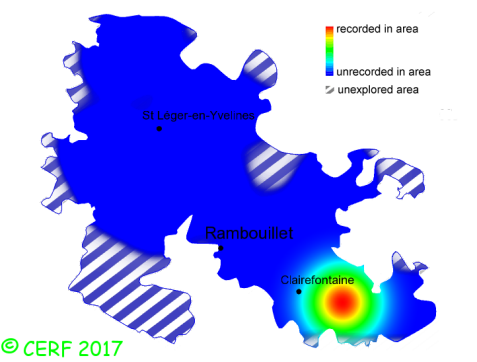|
Leccinum cyaneobasileucum fo. cyaneobasileucum (Lannoy & Estadès) Lannoy & Estadès
|
New classification: Basidiomycota/Agaricomycotina/Agaricomycetes/Agaricomycetidae/Boletales/Boletaceae
Former classification: Basidiomycota/Homobasidiomycetes/Agaricomycetideae/Boletales/Boletaceae
synonyms: Leccinum cyaneobasileucum
edibility : edible
|
|
|
The cap is pure white, sometimes stained with olive or russet, increasingly blue with age, fleshy, hemispherical at first, then convex.
The cap surface is downy to silky, tacky in wet weather.
The cap margin is slightly overhanging the tubes.
The stem is full, long and firm to tough, entirely white, rough because of the small scales covering it, these being pale for a long time, whitish to brownish in colour. It is often stained with blue-green spots at its base.
The flesh is thick, white. It turns slightly pink, or green-blue to blue (South Seas blue) in the stem base when cut and exposed to air, ; its taste is faint and mild; the odour is weak and pleasant;
The tubes are free, thin. They are whitish then cream-brown.
The pores are small, round, white then cream-brown, not turning blue when pressed.
The spore print is walnut-brown.
It grows in broad-leaved woods, mostly with birch, but not normally in sphagnum.
The fruiting period takes place from July to November.
| Dimensions: | width of cap approximately 8 cm (between 5 and 10 cm) |
| | height of stem approximately 11 cm (between 9 and 13 cm) |
| | thickness of stem (at largest section) approximately 20 mm (between 10 and 30 mm) |
Chemical tests : The flesh becomes : grey olive-green when in contact with iron sulphate, salmon to reddish pink when in contact with formaldehyde.
Distinctive features : entirely white body; silky-velvety cap; white, tough stem, covered with white-brown scales; blue-green stains at stem base; with birch
Leccinum cyaneobasileucum fo. cyaneobasileucum is rare and confined in the forest of Rambouillet, and is quite rare, more generally speaking
.
|  | | Above : distribution map of Leccinum cyaneobasileucum fo. cyaneobasileucum in the forest of Rambouillet |
|
page updated on 14/01/18
